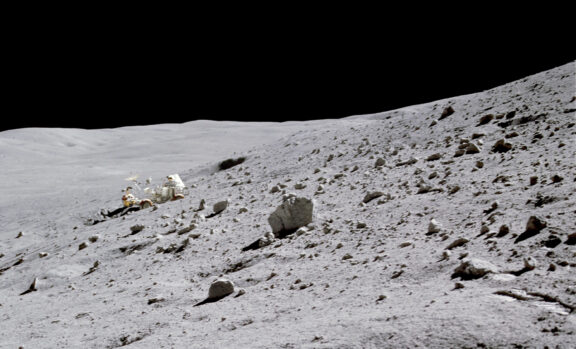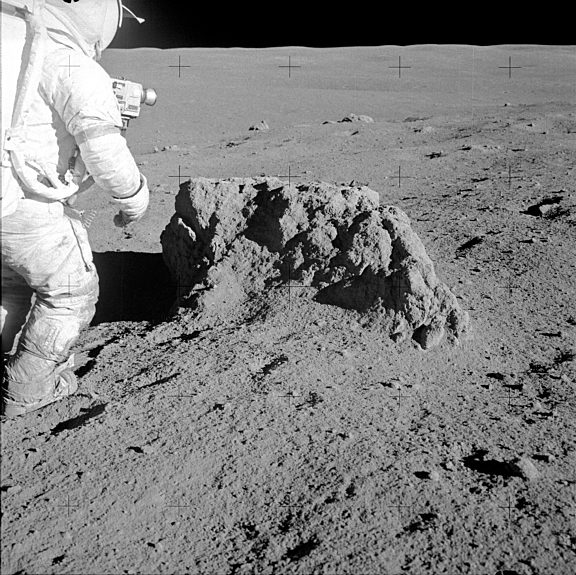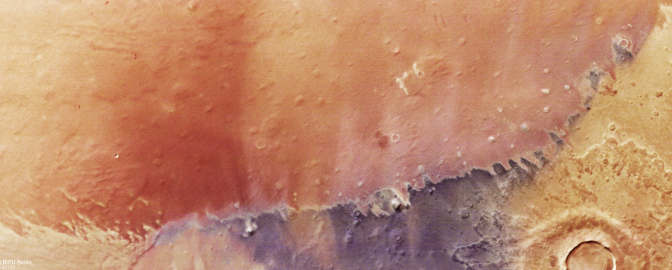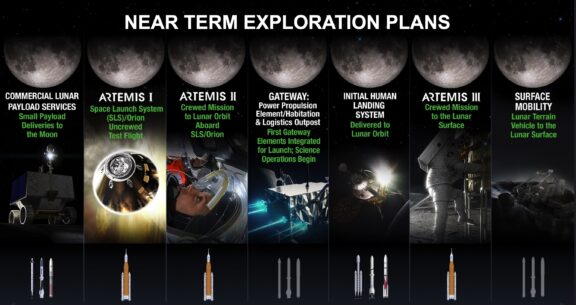Why send people back to the Moon?

Written by
Asa Stahl, PhD
Science Editor, The Planetary Society
July 24, 2025
Why send people back to the Moon?
During my PhD in astrophysics, I heard answers ranging from “because it’s cool” to “for humanity’s long-term survival,” but the rarest response I ever heard was “for science.” Even among astronomers, the idea of human space exploration is sometimes not taken seriously. If we’re going back to the Moon for the sake of science, some argue, wouldn’t we just send robots?

It’s easy to see crewed missions as all sizzle and no steak. They’re flashy. They involve “boots on the ground.” Robotic missions don’t tend to conjure the same feelings of national pride and personal inspiration. As Neil deGrasse Tyson once wrote, “Nobody's ever given a parade for a robot. Nobody's ever named a high school after a robot.”
Because of their relatively understated nature, you might assume that robotic missions are more scientifically impactful than crewed ones. In the end, though, it all comes down to one question: “What can Neil Armstrong do on the Moon that a robot can’t?”
The answer, it turns out, is quite a lot.
Back to the future
If all goes according to plan, NASA’s Artemis program will land astronauts on the Moon in 2027, then aim to build a sustained human presence there over time. Eventually, NASA hopes to establish a research base and a Moon-orbiting space station.
None of these grand plans to send people back to the Moon are made redundant by Apollo. Humanity has only spent about 12 days’ time on the Moon’s surface, and we have accomplished just a small fraction of the science that awaits us there. It would be a little presumptuous of us to think, “been there, done that,” about the Moon already. I wouldn’t feel that way about a country after 12 days, let alone an entire world.
And the Moon isn’t just any world: it’s a nearly pristine record of the Solar System’s past and a window into how Earth formed and developed life. The surface of the Moon is itself an ancient artifact, preserving billions of years of collisions with asteroids and comets. By studying the Moon up close, we can learn how impacts shaped the early Solar System and potentially delivered life’s ingredients to Earth. Likewise, asteroid impacts with the ancient Earth could have left pieces of our planet on the Moon — like time capsules — for future explorers to find.

Brains and brawn
This is where astronauts come in. Exploring a new world typically means two things: collecting samples and using instruments to gather data. Compared to robots, humans are sometimes better at both.
Take sampling. Rovers like NASA’s Perseverance are marvels of technology, but they have to be carefully controlled by experts on Earth to know where to go and what rocks to collect. Astronauts, on the other hand, can be experts themselves. They can make their own decisions and think outside the box, spotting unusual features and reacting to the unexpected.
Muscles matter, too. Astronauts simply can pick up bigger rocks than rovers can, and can pick up rocks faster, too. Each of the Apollo Moon landings returned with over ten times more samples than a typical robotic mission brings back. These rocks are a steady source of discoveries for scientists around the world, so the more we have, the better.
Astronauts can also get around faster than robots — because, despite what you might think, humans are often better drivers. Robots have a hard time navigating rough terrain on their own. But if you give an astronaut a car, they can easily avoid potholes and boulders on the Moon.

That means visiting more places and collecting samples farther afield. The crew of Apollo 17, for instance, drove roughly 35 kilometers (about 22 miles) on the Moon over three days. Traversing that same distance took NASA’s Opportunity Mars rover more than eight years.
An astronaut’s touch
Gathering data on another world sounds like something you could automate like a farm. But in many cases, it turns out to be more like running a garden: something that takes a delicate touch and a sense of nuance. That’s where people work best. Any experiment that requires careful handling, scouting, or setup is almost always better left to astronauts.
The instruments slated for Artemis III, the program’s first Moon landing mission, are perfect examples. Astronauts will have to carefully pick plants in a terrarium-like experiment, scout the ideal location for a soil probe, and adjust a seismometer to be in perfect contact with the ground. These tasks would be difficult for a robot to do, but are relatively simple for an astronaut.
Bigger, more complex experiments will depend on astronauts even more. Megaprojects like large drills, huge telescopes, and sprawling factories to extract resources may all need more construction and troubleshooting than robots can do on their own. This is why many people imagine a future for lunar exploration — at least, with anything resembling current technology — that depends on crewed missions.

Ex machina
This doesn’t mean humans are “better” at space exploration than robots. Each has its own strengths and weaknesses.
Robots can sit and monitor a world for years without getting bored. They make good advance scouts, since they don’t complain when there’s no air or food. And they can withstand harsh conditions, like the surface of Venus, to explore places where humans may never survive.
Crewed missions cost more but get things done faster. According to some experts, astronauts tend to be up to 100 times more expensive than rovers but up to 1,000 times more efficient. Stephen Squyres, a planetary scientist and principal investigator for the Spirit and Opportunity rovers, has said that an astronaut could finish a day’s worth of work for each rover in under a minute. Price is a real downside, though. Artemis is currently projected to cost over $90 billion through 2025, which is the price of around 30 complete Perseverance missions.
At the same time, sending humans everywhere a robot could go would be reckless, wasteful, and mind-bogglingly expensive. We don’t need an astronaut to travel to Jupiter and be exposed to deadly radiation just to take photos from orbit, and we definitely don’t need to send any astronauts on a one-way trip to fly by Pluto. On top of all this, space exploration is difficult, and missions fail. Space agencies have to carefully decide when it’s worth risking those in the cockpit. For all of those reasons, a successful space program uses robots and astronauts to complement one another.

Building the future
What astronauts learn on the Moon may only be the beginning. Artemis could represent the future of crewed space exploration beyond low-Earth orbit. If all goes according to plan, it will mean learning how to build habitats, extract resources, and test new systems for communications and life support. We may then be able to send expeditions elsewhere in the Solar System. With the lessons learned on the Moon, humanity would have a better sense of how to thrive in space.
If Artemis ends up being a scientific powerhouse, it won’t just be thanks to putting astronauts back on the Moon. One of its greatest impacts would come from putting us back on the Moon for the long term, if it can successfully build a sustained human presence there for a fraction of the cost of Apollo.
After all, what matters most isn’t whether exploration is robotic or crewed, but whether it’s sustained. Science works best when it’s a continuous effort, allowing knowledge to build on itself and unveil new discoveries.
So, the real question isn’t why we’re putting people back on the Moon. It’s what we’ll manage there with both robots and humans together.
Support our core enterprises
Your gift today will go far to help us close out the year strong and keep up our momentum in 2026.
Donate

 Explore Worlds
Explore Worlds Find Life
Find Life Defend Earth
Defend Earth


